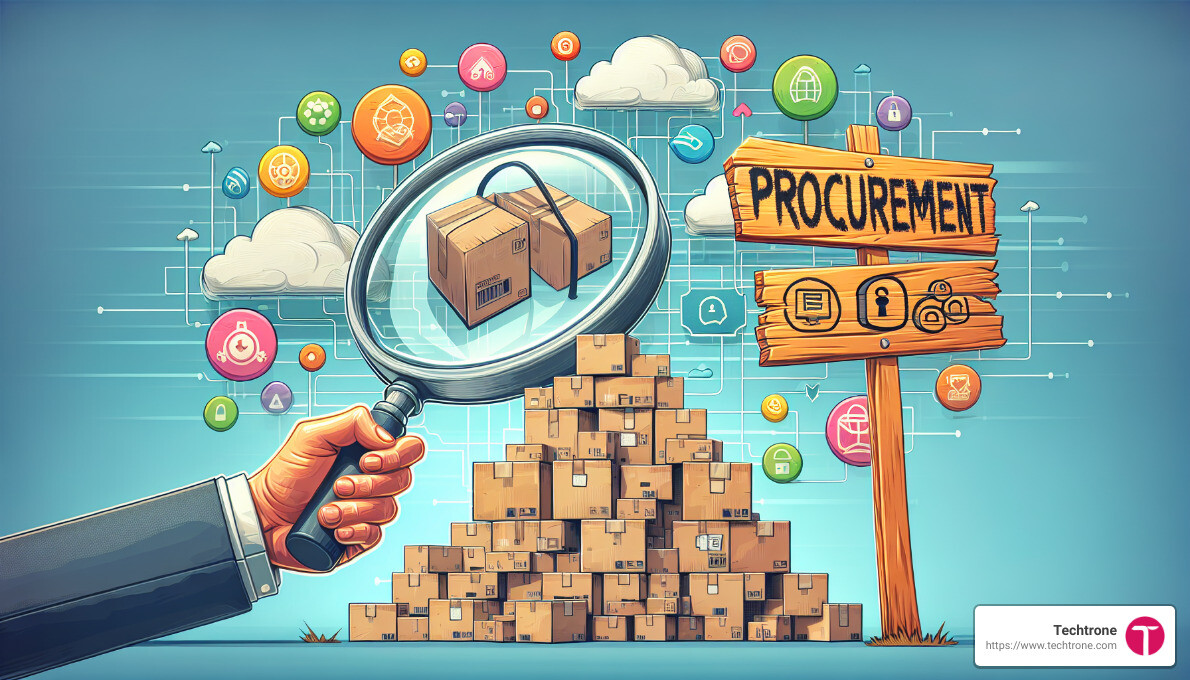Introduction
When small to medium-sized enterprise owners ask, “What are IT services for procurement?“, they’re seeking clarity on the essential elements and processes that integrate technology into their business operations efficiently. IT services for procurement encompass the crucial activities involved in sourcing and acquiring information technology services and products. This includes everything from initial planning and selection of appropriate technology to the management of vendor relationships and contracts.
Why is this important? Well, for any business aiming to stay competitive and agile in today’s market, having a robust IT procurement strategy is key. It not only ensures that you get the best tech solutions tailored to your specific needs but also impacts cost management, operational efficiency, and ultimately, your company’s bottom line.
However, the journey isn’t without its challenges. Companies often face hurdles like budget constraints, evolving technology standards, and the need for specialized skills to manage complex IT procurement landscapes.

Understanding the IT procurement process, its significance, and the common obstacles businesses encounter are the first steps toward mastering this critical business function. By navigating these challenges strategically, businesses can harness the power of technology to propel themselves towards greater success.
What is IT Procurement?
Definition
IT procurement is the process of acquiring technology-related goods and services that are essential for an organization to operate and compete effectively in the digital age. This includes everything from software and hardware to IT consulting services and network infrastructure.
Strategic Importance
The strategic importance of IT procurement cannot be overstated. In today’s business environment, technology is a critical enabler of efficiency, innovation, and competitiveness. Effective IT procurement ensures that a business has access to the latest and most suitable technologies, which can lead to significant advantages:
- Enhanced Operational Efficiency: By automating and optimizing processes.
- Increased Security: Through up-to-date and robust IT solutions.
- Cost Savings: By carefully selecting vendors and negotiating favorable terms.
- Scalability: Enabling businesses to grow seamlessly with the right tech infrastructure.
IT Procurement Models
There are several models of IT procurement that organizations can adopt, depending on their size, needs, and strategic goals:
-
Centralized Procurement: All procurement decisions and processes are handled by a single, central department. This model offers better control over purchasing and can leverage economies of scale.
-
Decentralized Procurement: Individual departments or business units make their own IT procurement decisions. This can lead to faster, more tailored decisions but might incur higher costs and less consistency.
-
Hybrid Model: Combines elements of both centralized and decentralized models. Strategic decisions are made centrally, while specific IT needs can be addressed at the departmental level.
Each model has its advantages and challenges, and the choice largely depends on the organization’s structure, culture, and business objectives.
Understanding these foundational elements of IT procurement helps businesses not only make informed decisions about technology investments but also aligns those decisions with broader business strategies. This alignment is crucial for driving business growth and maintaining competitive edge in a rapidly evolving digital landscape.
Key Components of IT Services for Procurement
When discussing IT services for procurement, understand the major components that make up this critical business function. These components include Software, Cloud Services, Hardware, and IT Consultancy. Each plays a vital role in ensuring that an organization’s IT infrastructure is robust, scalable, and aligned with its business objectives.
Software
Software is the backbone of almost every business operation. From basic office productivity tools to complex enterprise resource planning systems, software enables businesses to perform a plethora of tasks efficiently. In the realm of IT procurement, software solutions help manage procurement processes, track inventory, handle supplier relationships, and much more. They are essential for automating tasks that were traditionally manual, reducing the likelihood of errors, and increasing efficiency.
Cloud Services
Cloud services have revolutionized how businesses operate by offering scalable resources that can be used on-demand without the heavy initial investment in physical hardware. For IT procurement, cloud-based platforms facilitate better collaboration among team members who are managing procurement tasks from different locations or even remotely. These services provide flexibility and accessibility, allowing procurement processes to be more agile and adaptable to changing business needs.
Hardware
Despite the shift towards cloud services, hardware still remains a crucial component of IT services for procurement. Servers, routers, switches, and data storage devices form the physical foundation upon which IT networks operate. Procuring the right hardware is critical to ensure that the IT infrastructure is not only capable of meeting current demands but is also future-proof to handle potential growth and technological advancements.
IT Consultancy
Navigating the complex world of IT procurement requires expertise and strategic planning, which is where IT consultancy comes into play. IT consultants offer specialized knowledge that helps businesses identify their IT needs, choose the right technology solutions, and implement those solutions effectively. They play a crucial role in ensuring that the procurement of IT services aligns with the company’s long-term strategic goals and provides the best return on investment.
Understanding these key components helps organizations streamline their IT procurement processes and ensures they are equipped with the right tools and strategies to support their operational needs. This foundational knowledge is not only crucial for making informed decisions but also for aligning IT procurement with broader business strategies, thus driving growth and maintaining a competitive edge in a rapidly evolving digital landscape.
The IT Procurement Process Explained
When we talk about IT procurement, we’re diving into a systematic approach that ensures your company gets the right technology solutions that meet specific needs without overspending or underperforming. Let’s break down the core steps involved: Identifying Needs, Vendor Selection, Contract Management, and Quality Assurance.
Identifying Needs
The first step in the IT procurement process is Identifying Needs. It’s all about understanding what different departments in your organization require to perform optimally. This might include faster hardware for the design team or more robust software for customer management. It’s crucial to talk to end-users and use tools like surveys or feedback sessions to gather detailed insights about their daily challenges and needs.
Vendor Selection
Once you know what you need, the next step is Vendor Selection. This involves researching and shortlisting the best suppliers who can provide the technology solutions your business requires. During this phase, you not only look at the cost but also consider the vendor’s reputation, support offerings, and the long-term viability of their products. Engaging stakeholders during vendor selection can help in making a choice that everyone trusts and supports.
Contract Management
After selecting a vendor, the next crucial phase is Contract Management. This involves negotiating terms that protect your interests and setting clear expectations about deliverables, timelines, and service levels. Effective contract management ensures that both parties are on the same page and reduces the risk of conflicts. It’s also about having a clear plan for ongoing monitoring and management of the contract to ensure compliance and performance.
Quality Assurance
Lastly, Quality Assurance in IT procurement is about making sure that the products and services procured meet the specified requirements and standards. This might involve stages of testing products, conducting pilot runs, and having regular quality checks to catch and resolve issues early. Ensuring quality is crucial for the reliability of IT systems and can prevent costly downtime or repairs later.
By following these structured steps, organizations can enhance their IT procurement process, making it more efficient and aligned with their strategic goals. This approach not only ensures that you get the best technology solutions but also maintains a strong relationship with vendors, leading to better service and innovations. We’ll explore common challenges in IT procurement and practical strategies to overcome them, ensuring your procurement processes are as smooth and effective as possible.
Challenges in IT Procurement and How to Overcome Them
Procuring IT services and products can be tricky. Businesses often face hurdles that can stall or even derail their IT procurement projects. Let’s dive into some common challenges and explore practical solutions.
Inadequate Budgeting
The Problem: Often, businesses underestimate the funds required, leading to compromised service quality and performance. Insufficient budgeting can hinder negotiations with service providers, affecting the terms and overall costs.
The Solution: Start with a detailed financial plan. Include all possible expenses like technical support, maintenance, and unexpected costs. Regularly review and adjust the budget as the procurement process progresses to avoid surprises.
Unclear Requirements
The Problem: If the business needs are not clearly defined, it results in purchasing unnecessary services or hiring vendors who aren’t the right fit. This misalignment can lead to wasted resources and failed projects.
The Solution: Develop a comprehensive list of requirements before you start the vendor selection process. Engage stakeholders from relevant departments to contribute insights, ensuring all business needs are accurately captured and communicated.
Lack of Appropriately Skilled Personnel
The Problem: Without the right expertise, businesses struggle to evaluate and select the best vendors. This can lead to poor decision-making and inadequate fulfillment of technical requirements.
The Solution: Invest in training your procurement team or hire specialists with experience in IT procurement. Consider partnering with IT procurement consultants who can provide the necessary knowledge and support.
Difficulties Managing Relationships
The Problem: Managing relationships with multiple vendors can be complex. Poor communication and lack of collaboration can lead to unmet service requirements and strained relationships.
The Solution: Focus on building strong communication channels and regular interactions with your vendors. Establish clear objectives and expectations from the start. Regular feedback and collaborative problem-solving sessions can help maintain strong partnerships.
Security Risks
The Problem: Increased reliance on digital technologies invites various security risks, including data breaches and compliance issues. This is especially critical when dealing with sensitive data and adhering to regulations like GDPR or HIPAA.
The Solution: Implement strict security policies and ensure that all vendors comply with relevant regulations. Conduct regular security audits and insist on compliance certificates from your IT service providers. Equip your team with the tools and knowledge to manage and mitigate security risks effectively.
By addressing these challenges with strategic planning and proactive management, businesses can smooth out the bumps in their IT procurement process. Each solution not only resolves the immediate issues but also strengthens the overall procurement strategy, leading to more successful outcomes and robust IT systems. We will delve into best practices that can further refine your IT procurement efforts, ensuring you leverage the best of technology to drive your business forward.
Best Practices for Effective IT Procurement
When diving into IT procurement, it’s vital to have a strategy that ensures efficiency, cost-effectiveness, and alignment with business goals. Here, we outline some best practices that can guide you through successful IT procurement.
Market Research
Understand the Landscape: Before you make any decisions, know what’s out there. This means identifying potential vendors, understanding current market trends, and knowing the average costs and technological standards. For instance, using platforms like G2 can help you access software analyst insights and peer reviews which are crucial in making informed decisions.
Stay Updated: Technology evolves rapidly. Regularly updating your market knowledge helps keep your procurement strategy relevant and competitive.
Stakeholder Engagement
Involve Relevant Parties Early: From the start, include stakeholders from various departments such as IT, finance, and the end-users of the technology. This ensures the procured technology meets all functional requirements and is well-received across the board.
Continuous Communication: Keep stakeholders in the loop through regular updates and feedback sessions. This not only builds trust but also enables you to adjust your procurement strategy based on real-time input and feedback.
Vendor Evaluation
Set Clear Criteria: Define what you expect from your vendors in terms of product capabilities, support, and service levels. Tools like the RFP can guide you in gathering detailed information from vendors, ensuring they meet your specific needs.
Check References and Reviews: Don’t just take the vendor’s word for it. Look at their track record, ask for customer references, and check independent reviews. This helps gauge their reliability and the quality of their service.
Risk Management
Identify Potential Risks: Understand the risks associated with each vendor and technology choice. These could range from data security risks to compliance and operational risks.
Develop Mitigation Strategies: Once risks are identified, work on strategies to mitigate them. This could include setting up robust security measures, ensuring vendor compliance with industry standards, and having contingency plans in place.
By integrating these practices into your IT procurement process, you not only streamline the acquisition of IT services but also ensure they add value and support to your organization’s objectives. Implementing these strategies will prepare you to navigate the complexities of IT procurement effectively, leading to successful technology adoption and integration.
Frequently Asked Questions about IT Services for Procurement
What does an IT procurement do?
IT procurement involves the systematic process of sourcing and acquiring the technology services or products necessary for an organization’s operations. This includes everything from negotiating terms and prices with vendors, managing contracts, ensuring that the technology meets the specific needs of the business, and maintaining a relationship with suppliers. The goal is to secure the best possible technology at the most favorable terms, which supports the organization’s overall strategy and operational efficiency.
Examples of procurement services?
Procurement services can vary widely depending on the needs of the organization, but here are some common examples:
– Software Licensing and Management: Acquiring the rights to use various software tools, including updates and support.
– Hardware Purchasing: Buying physical IT equipment like servers, computers, and networking devices.
– Cloud Services: Subscription-based services such as data storage, computing power, and business applications hosted on the cloud.
– Consultancy and Support Services: Expert advice and ongoing support to optimize the use and implementation of IT resources.
– Maintenance and Upgrades: Scheduled services to ensure IT systems are up-to-date and running smoothly.
What is the IT based procurement process?
The IT-based procurement process is a structured approach that leverages technology to enhance the efficiency and effectiveness of procurement activities. Here’s a simplified overview:
1. Need Identification: Clearly defining what technology or service is required to meet business objectives.
2. Market Research: Gathering information about potential suppliers and the latest technological advancements.
3. Vendor Shortlisting: Selecting a few potential vendors based on their capability to meet the specified needs.
4. Request for Proposal (RFP): Sending out detailed documents to shortlisted vendors, asking them to propose their solutions and quotes.
5. Evaluation and Selection: Assessing the proposals based on set criteria such as cost, service quality, and vendor reliability.
6. Negotiation and Contracting: Discussing terms and conditions with the chosen vendor and finalizing the contract.
7. Implementation and Monitoring: Overseeing the deployment of IT services and evaluating their performance against agreed benchmarks.
By incorporating these steps, organizations can make informed decisions that align with their strategic goals and ensure they get the best value from their IT investments. This process is crucial for managing costs, enhancing service quality, and mitigating risks associated with IT procurement.
Conclusion
As we wrap up our comprehensive guide on IT services for procurement, it’s clear that the landscape of IT procurement is both vast and intricate. At Techtrone, we specialize in simplifying this complex process, particularly for small enterprises that are striving to grow in a competitive digital environment.
Techtrone: Boosting Small Enterprises through Innovative IT Solutions
Our approach to IT procurement is designed to support your business at every stage of its growth. Here’s how we empower small enterprises:
- Strategic IT Solutions: We provide tailored IT solutions that align with your specific business needs, ensuring that your technology investments drive substantial business value.
- Cost-Efficiency: We focus on delivering solutions that not only meet your current needs but also come with a competitive price tag, ensuring that every dollar spent is an investment towards your business’s growth.
- Scalability: Our IT services are designed to grow with your business. From initial setup to expansion phases, our solutions adapt to your changing needs, ensuring seamless transitions and scalability.
- Innovation: By leveraging the latest technologies, we help you stay ahead of technological trends, giving you a competitive edge in your industry.
- Risk Management: We understand the risks involved in IT procurement—from data security to compliance issues. Our experts ensure that all solutions not only meet industry standards but also come with robust security measures to protect your valuable data.
For small enterprises, the journey through digital transformation can be daunting. However, with Techtrone as your partner, you can navigate this landscape with confidence. Our commitment to providing high-quality, innovative, and cost-effective IT solutions ensures that your business is well-equipped to meet the challenges of today’s business environment.
Explore our IT services and discover how we can help you achieve your business goals. Learn more about our IT services for procurement.
By choosing Techtrone, you’re not just purchasing IT solutions; you’re investing in a partnership that will propel your business forward in the digital age. Let us help you turn your IT investments into a powerful engine for growth and success.



